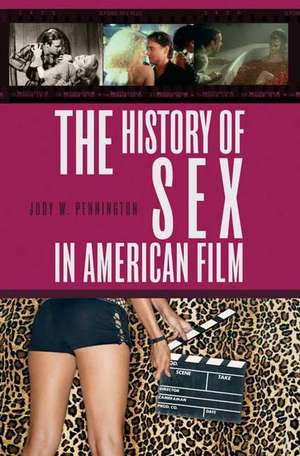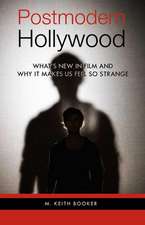The History of Sex in American Film
Autor Jody Penningtonen Limba Engleză Hardback – 29 iul 2007 – vârsta până la 17 ani
Preț: 321.73 lei
Preț vechi: 392.14 lei
-18% Nou
Puncte Express: 483
Preț estimativ în valută:
61.58€ • 66.91$ • 51.76£
61.58€ • 66.91$ • 51.76£
Carte tipărită la comandă
Livrare economică 21 aprilie-05 mai
Preluare comenzi: 021 569.72.76
Specificații
ISBN-13: 9780275992262
ISBN-10: 0275992268
Pagini: 232
Dimensiuni: 156 x 235 x 23 mm
Greutate: 0.51 kg
Editura: Bloomsbury Publishing
Colecția Praeger
Locul publicării:New York, United States
ISBN-10: 0275992268
Pagini: 232
Dimensiuni: 156 x 235 x 23 mm
Greutate: 0.51 kg
Editura: Bloomsbury Publishing
Colecția Praeger
Locul publicării:New York, United States
Notă biografică
Jody W. Pennington is Associate Professor in Media and Culture Studies at the Department of English, University of Aarhus, Denmark, where he teaches Media and Cultural Studies as well as American Studies. He has published articles and presented papers on various aspects of film and popular music, as well as American constitutional law. He is currently president of the Danish Association of American Studies.
Recenzii
Pennington delivers an overview of the intersection of sexual mores, censorship, and film portrayals of sexuality. The volume is a useful introductory tool.. Recommended. Undergraduates; general readers.
Pennington traces the development of visual and thematic sexual content, the ensuing conservative vs. liberal controversies, and the impact of resulting censorship codes and legal rulings with their shifting guidelines. Using numerous in-depth examples of films, citing specific plotlines, and offering pertinent descriptions of relevant scenes. Pennington thoughtfully analyzes the interrelationship of film and American society in terms of sexual attitudes and psychology, examining changing values, prejudices, boundaries, and norms within historical and cultural contexts..Throughout, he reveals the close but complex alliance between film and life. For academic and large film collections
This work by Pennington is a social and cultural history of the representation of sex and its regulation in American cinema. She takes a chronological approach to the film industry's self-censorship regimes through the mid-1960s, non-mainstream film most affected by obscenity law, sexual themes in the films that helped put an end to the Production Code, changing American attitudes towards sex and their reflection in film through the 1980s, and the present-day conservative counterattack on liberal sexual realignment as it has played out in film. Remaining chapters adopt a more thematic approach and offer analysis of the revision of sexual representation of the past following the demise of the Production Code and representations of homosexuality, adultery, and pedophilia.
Pennington traces the development of visual and thematic sexual content, the ensuing conservative vs. liberal controversies, and the impact of resulting censorship codes and legal rulings with their shifting guidelines. Using numerous in-depth examples of films, citing specific plotlines, and offering pertinent descriptions of relevant scenes. Pennington thoughtfully analyzes the interrelationship of film and American society in terms of sexual attitudes and psychology, examining changing values, prejudices, boundaries, and norms within historical and cultural contexts..Throughout, he reveals the close but complex alliance between film and life. For academic and large film collections
This work by Pennington is a social and cultural history of the representation of sex and its regulation in American cinema. She takes a chronological approach to the film industry's self-censorship regimes through the mid-1960s, non-mainstream film most affected by obscenity law, sexual themes in the films that helped put an end to the Production Code, changing American attitudes towards sex and their reflection in film through the 1980s, and the present-day conservative counterattack on liberal sexual realignment as it has played out in film. Remaining chapters adopt a more thematic approach and offer analysis of the revision of sexual representation of the past following the demise of the Production Code and representations of homosexuality, adultery, and pedophilia.












